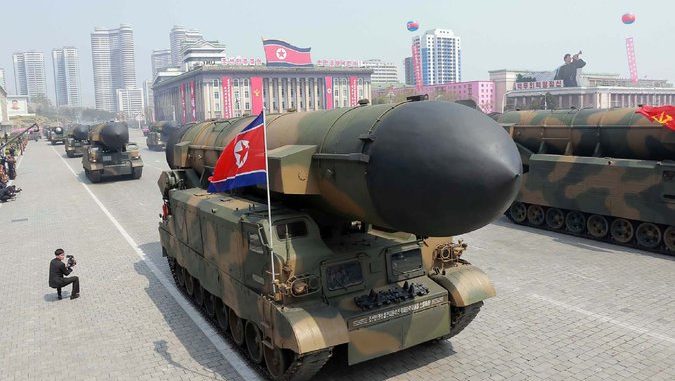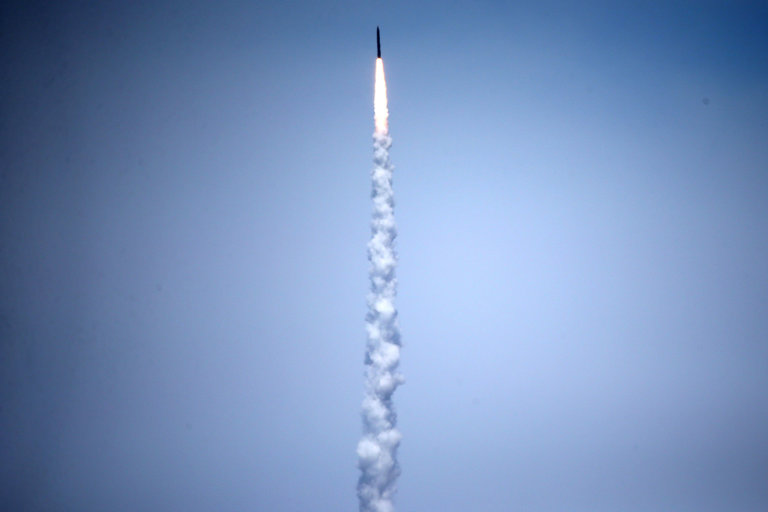
In 9 of 17 tests since 1999, target missile NOT destroyed. Record has not improved over time, as expected for successfully maturing system, which “demonstrates limited capability to defend US from small numbers” of medium- and long-range missiles “launched from North Korea or Iran,” according to Pentagon report in January. “Tests have still not been done under realistic conditions.” Only when system is tested in a range of situations — such as at night, or when an adversary is using countermeasures, as would happen in any real attack — would Defense Department be able to say it works. Tuesday’s test was launched from Kwajalein Atoll in the Marshall Islands. Because location was known and approximate time of launch planned, the interceptor was ready — which will almost certainly not be the case under real conditions. North Koreans recently test-fired a series of missiles based on solid-fuel technology that would give US little warning of attack. New solid fuel missiles can be launched in minutes. That makes already daunting job of intercepting them far harder, given that US antimissile system only “works” with early alerts from satellites that a launch is imminent. Top: Ballistic missiles paraded through Pyongyang, North Korea’s capital in April. Below: An interceptor rocket that is part of the US’ ballistic missile defense program launched during flight test from Vandenberg Air Force Base in California on Tuesday. Pentagon says test was successful, but gave no details, and there has been no independent confirmation.
A re-engineered US interceptor rocket collided with a mock intercontinental ballistic missile on Tuesday afternoon in the skies over the Pacific Ocean, the Pentagon said,
in the first “successful” test of whether it could shoot down a warhead from North Korea racing toward the continental US at speeds approaching true battle conditions.
At a time when tensions with North Korea are running high, a “successful” test was vital for the Defense Department’s beleaguered missile defense program.
It enabled the Pentagon to argue that it is making strides in protecting the United States from a North Korean nuclear warhead.
But even advocates of the program stop short of arguing that it can now provide a defensive shield;
with Tuesday’s test, only five of the last 10 tests have been declared fully or partly successful in the 13 years since the system became operational.
The results of the test were being watched carefully, not only because a failure would have been a major setback, but also because a redesigned interceptor was put up against a dummy warhead that was speeding toward the United States at a velocity close to that of a real incoming missile.
The test “demonstrates that we have a capable, credible deterrent against a very real threat,” said Vice Adm. James D. Syring, the director of the Pentagon’s Missile Defense Agency, calling the test a “critical milestone for this program.”
But Defense Department officials provided no details,
saying only that initial indications showed the test had met its primary objective by hitting the target
and that the missile agency would evaluate other data to determine how the system performed over all.
The test was the first of a new “kill vehicle” that uses thrusters to aim directly at an incoming warhead.
That is intended to solve a persistent technical problem blamed for many past misses.
So far, North Korea has not tested a missile that could reach the United States.
But experts expect that moment in the next five years or so.
To truly threaten the US, North Korea would have to demonstrate it has a missile that can reach the West Coast or farther inland,
and it would have to learn how to shrink a nuclear warhead to fit atop an intercontinental missile and survive the stresses of re-entering the atmosphere.
But Pyongyang has also been working hard to overwhelm the defense systems that the Pentagon has placed
in California, where the antimissile system was tested on Tuesday, and in Alaska.
US “Success” Only Against Single Warheads – NK Will Fire Multiple Salvos
For instance, North Korea regularly practices firing salvos of missiles
because the US system is designed to intercept only one or two incoming warheads at a time.
Analyses of recent North Korean flight tests and missiles paraded through the streets of Pyongyang suggest
that the North may also be seeking to develop maneuverable warheads.
Such a tactic, if successfully developed, would help warheads dodge antimissile interceptors,
hence completely obviating any US claims of “success” in developing anti-missile defense.
For that reason, President Barack Obama ordered in 2014 that
the traditional missile defenses be supplemented by a covert program intended to sabotage launches before they happen.
That program includes electronic warfare attacks, but it is unclear how successful it has been.
“Left of Launch”/ “Right of Launch”, Anti-Missile STILL An Expensive Fantasy
Experts say that a combination of that “left of launch” sabotage, so called because it comes BEFORE OR JUST AS a missile launches,
and “right of launch” interception of AIRBORNE missiles, the kind practiced on Tuesday,
represent the best chance of protecting the United States.
Efforts to test the country’s multibillion-dollar efforts at missile defense have had mixed results.
A Pentagon report in January criticized the long-range system,
saying that it “demonstrates a limited capability to defend the U.S. homeland from small numbers” of medium- and long-range missiles “launched from North Korea or Iran.”
In nine of the 17 tests of the system since 1999, the target missile was not destroyed, officials said.
Critics of the system say the test record has not improved over time, as would be expected for a system that is maturing.
And “the tests have still not been done under realistic conditions,”
Laura Grego, a physicist with the Union of Concerned Scientists, wrote in a blog post on Monday.
Ms. Grego and other scientists argue that only when the system is tested in a range of situations —
such as at night, or when an adversary is using countermeasures —
would the Defense Department be able to say that it works.
Tuesday’s test was launched from Kwajalein Atoll in the Marshall Islands.
Because the location was known and the approximate time of the launch was planned,
the interceptor was ready — which will almost certainly not be the case under real conditions.
The North Koreans recently test-fired a series of missiles based on a technology that would give the US little warning of an attack.
Their new missiles use solid fuels and can be launched in minutes.
That makes the already daunting job of intercepting them far harder,
given that the American antimissile system works best with early alerts from satellites that a launch is imminent.
These missiles, officials say, appear to be functional, unlike older missiles that kept exploding or falling into the sea.
Recent major tests were clearly successful, teaching the North Koreans a lot about how to fire missiles into space and drop warheads on distant targets.
While the American missile defense test was not “timed specifically to the current tensions,” the North “remains a cause for concern,” Capt. Jeff Davis, a Pentagon spokesman, said on Tuesday.
“They’re expanding in the size and sophistication of their ballistic missile systems, from close range to intercontinental,
and they continue to conduct test launches while also using dangerous rhetoric that suggests they want to strike the US.”
Trump Didn’t Tell South Korea US Launchers Were Deployed There
In South Korea on Tuesday, President Moon Jae-in ordered an investigation into why the nation’s Defense Ministry had failed to inform him that
four additional launchers for a contentious American missile-defense battery had been brought into the country.
The US hurried to deploy the antimissile system, called the Terminal High Altitude Area Defense, or THAAD, in April
despite protests from Moon, who was a presidential candidate at the time, and
demanded that the deployment be delayed until after the new government in Seoul reviewed whether it was in the country’s best interest.
On Monday, Pyongyang launched what South Korean officials called a Scud-type missile that flew 280 miles before falling into waters near Japan.
Hours after the missile test, two American supersonic B-1B Lancer bombers conducted a drill over South Korea.
As a candidate, Moon had called for a parliamentary review of the THAAD system.
Two interceptor-rocket launchers were first put in place in Seongju, 135 miles southeast of Seoul, during the April deployment,
although a THAAD battery normally operates with six launchers.
Moon had accused both Washington and the government of the impeached President Park Geun-hye of trying to make the THAAD deployment a fait accompli.
Since Moon’s election on May 10, he has not been as vocal about the THAAD deployment.
That changed on Tuesday, when he learned that the remaining four Thaad launchers had arrived in South Korea —
although not put in place in Seongju — and that his office had not been notified.
“President Moon called it a great shock,” said his spokesman, Yoon Young-chan.
“He ordered a probe on
- how the four launchers were brought into the country,
- whose decision it was,
- why it has not been made public to the people and
- why it has not been reported to the new government until now.”
Source: Missile Defense Test Succeeds, Pentagon Says, Amid Tensions With North Korea – The New York Times
